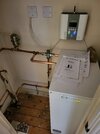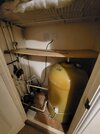Our dogs have a room, with outside door. The door from that to house is "sealed", so the dogs can have their door open without effecting balance of MVHR to rest of house ... dunno if your arrangement would allow that though. It suits us because the inner door is basically an external door, and has a proper lock. So when we go out we lock the inner door, leave the dogs outer door closed, but unlocked, and if we are unexpectedly delayed we can ask neighbours to rescue the dogs!
MVHR needs to be balanced - I'm sure obvious, but if the house leaks air somewhere then the exhaust air going through the MVHR is less than incoming ... and heat transfer is diminished. That apart, leaving doors / windows open is fine, it is just not a good idea at times when you would like to preserve the temperature of the house - i.e. it is either blinking cold outside, or blinking hot. At those times keeping everything shut is helpful to maintain the temperature, but that apart opening everything is fine. We use evening-venting in heatwave to cool the house. It isn't hot, but it will become hot over the course of 7 - 14 days prolonged heat if we do nothing ... and then the heat is quite hard to get rid of Natch! so at such times we cool it by opening windows of an evening. Cool air comes in, room temperature drops, fabric of the house absorbs that "coolness" ... then we close the windows, and the room temperature immediately bounces back! 'coz substantively altering the temperature of the fabric of the building takes a lot of Therms. A good thing, for constant temperature maintenance, but a nuisance if the house gets either very hot or cold - takes a lot of effort to get it back again

When we have guests in Summer it is quite common for them to throw the windows open in the morning <sigh>. Net effect the room heats up, and they will be too hot tonight. The ducted air is pumping through as much fresh air in a day as an open window for a few hours would do, so there is no need. But people think it weird that we don't routinely open windows ... personally I'd like to keep all the flies etc. out of the house ... and the pollen and dust.
Understood; we too did ours when it died (in 2008) and needed replacing anyway. I'm retirement age now and glad I had all that disruption back then





